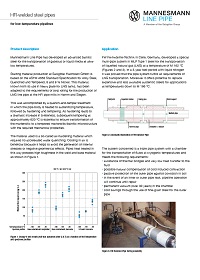HFI-steel pipes for low-temperature pipelines
The technical advantages of liquefied natural gas (LNG) in the storage and long-distance transportation have led to its increasing use for years now. However, the necessary cooling of natural gas to between -161 und 164 °C places high requirements on LNG storage tanks and pipelines, which to some extent reduces its economic efficiency. This is not least due to the fact that storage tanks and pipes were frequently made from austenitic steels, which are expensive and not always readily available. Hence, the development of new, more cost-efficient steel grades for low-temperature service is a research priority in the field of LNG applications.
An important achievement in this area is a sophisticated bainitic steel developed within the Salzgitter Group. Our starting material producer, Salzgitter Mannesmann Flachstahl, has successfully used a heat-treated 8 to 9 % nickel steel in the production of plate for LNG tanks. We have further developed this material, and it can now also be used for the production of hot rolled coils as starting material for HFI-welded steel pipe.
The new material grade is achieved by heat treatment in the form of a time-controlled, multi-step full-body annealing and cooling process. Austenitization is followed by a hardening process. Due to the increasing susceptibility to brittle fracture associated with this process step, a tempering treatment within a defined temperature range is necessary for optimization of the microstructure. Cooling takes place in air, to avoid internal stress and geometrical deviations in the pipe. In subsequent mechanical tests, both the base material and the HFI-weld demonstrate high toughness.
A perfectly matching complementary technology has been developed by FW Fernwärme-Technik in Celle for LNG transportation: a special multi-pipe system (FW-Kammer pipe) made from our new material. In a 3-year test phase with liquefied nitrogen, this pipe has successfully met all requirements of LNG transportation even at -196 °C.


